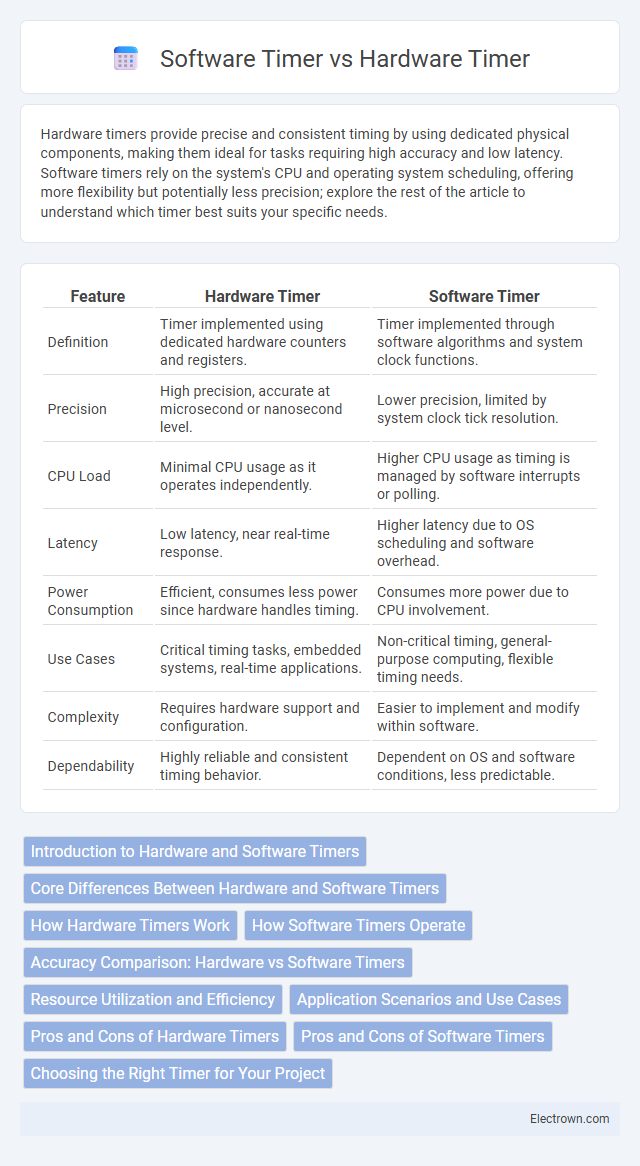Hardware timers provide precise and consistent timing by using dedicated physical components, making them ideal for tasks requiring high accuracy and low latency. Software timers rely on the system's CPU and operating system scheduling, offering more flexibility but potentially less precision; explore the rest of the article to understand which timer best suits your specific needs.
Table of Comparison
| Feature | Hardware Timer | Software Timer |
|---|---|---|
| Definition | Timer implemented using dedicated hardware counters and registers. | Timer implemented through software algorithms and system clock functions. |
| Precision | High precision, accurate at microsecond or nanosecond level. | Lower precision, limited by system clock tick resolution. |
| CPU Load | Minimal CPU usage as it operates independently. | Higher CPU usage as timing is managed by software interrupts or polling. |
| Latency | Low latency, near real-time response. | Higher latency due to OS scheduling and software overhead. |
| Power Consumption | Efficient, consumes less power since hardware handles timing. | Consumes more power due to CPU involvement. |
| Use Cases | Critical timing tasks, embedded systems, real-time applications. | Non-critical timing, general-purpose computing, flexible timing needs. |
| Complexity | Requires hardware support and configuration. | Easier to implement and modify within software. |
| Dependability | Highly reliable and consistent timing behavior. | Dependent on OS and software conditions, less predictable. |
Introduction to Hardware and Software Timers
Hardware timers are physical components integrated into microcontrollers or processors that provide precise timing and counting functions independent of the main CPU. Software timers rely on system clock interrupts and software routines to simulate timing, offering flexibility but less accuracy and higher CPU overhead. Both timers are essential in embedded systems for managing delays, periodic tasks, and event scheduling with hardware timers preferred for critical timing accuracy.
Core Differences Between Hardware and Software Timers
Hardware timers operate independently of the CPU by using dedicated circuitry to measure time intervals with high precision and low latency. Software timers rely on the system's processor and operating system, making them more flexible but susceptible to delays due to CPU load and multitasking. Your choice between hardware and software timers depends on the required timing accuracy, real-time performance, and resource availability in your application.
How Hardware Timers Work
Hardware timers operate by counting clock pulses generated from a precise oscillator within a microcontroller, enabling accurate time measurement and event scheduling. These timers increment a register at each clock cycle, triggering interrupts or flags when reaching a predefined value, thus providing reliable timing regardless of CPU load. Your system's real-time performance benefits from hardware timers as they function independently of software execution speed or operating system delays.
How Software Timers Operate
Software timers operate by utilizing the system's main processor and an underlying hardware timer or system tick to track elapsed time, often implemented within an operating system or real-time scheduler. These timers rely on periodic interrupts triggered by a hardware timer, incrementing a global counter or maintaining a timestamp, which software routines then compare to target intervals to determine timer expiration. Unlike hardware timers that run independently, software timers depend on CPU execution and scheduling, making them flexible but subject to process delays and system load.
Accuracy Comparison: Hardware vs Software Timers
Hardware timers provide superior accuracy due to their dedicated circuitry operating independently from the CPU, enabling precise time measurements down to microseconds or nanoseconds. Software timers rely on CPU cycles and operating system scheduling, making them susceptible to delays and jitter, which reduces timing precision especially under heavy system load. Real-time applications demanding strict timing constraints prefer hardware timers to ensure minimal latency and consistent interval triggering.
Resource Utilization and Efficiency
Hardware timers offer superior resource utilization and efficiency by operating independently of the CPU, allowing precise timing without processor intervention. Software timers rely on CPU cycles and interrupts, which can increase processing overhead and reduce system responsiveness. Choosing hardware timers ensures minimal latency and optimal performance, especially in real-time applications where your system demands precise timing control.
Application Scenarios and Use Cases
Hardware timers excel in real-time embedded systems requiring precise timing control, such as motor control, pulse-width modulation (PWM), and interrupt generation for critical tasks. Software timers are ideal for less time-sensitive applications like task scheduling, delayed execution, and timeout management in operating systems or user-level programs. Real-time operating systems often combine both to optimize resource management and timing accuracy across diverse application scenarios.
Pros and Cons of Hardware Timers
Hardware timers offer precise timing control with low CPU overhead, making them ideal for real-time applications and accurate event scheduling. They run independently of the processor, reducing latency and improving system efficiency. However, hardware timers are limited by fixed resources on the microcontroller, lack flexibility in configuration, and can increase design complexity and cost when multiple timers are required.
Pros and Cons of Software Timers
Software timers offer flexibility in timing operations without requiring dedicated hardware resources, allowing multiple timers to run concurrently with varying intervals. However, they depend on the processor's execution cycle, which may introduce latency and variability due to multitasking or interrupts, leading to less precise timing compared to hardware timers. Software timers also consume CPU resources, potentially impacting system performance in time-critical applications.
Choosing the Right Timer for Your Project
Choosing the right timer for your project depends on precision requirements and resource availability. Hardware timers provide high accuracy and low latency by utilizing dedicated microcontroller peripherals, making them ideal for time-critical applications like motor control and real-time systems. Software timers, implemented through system interrupts or OS schedulers, offer flexibility and ease of use but may suffer from latency and less precise timing due to processor load or interrupt delays.
Hardware timer vs software timer Infographic

 electrown.com
electrown.com